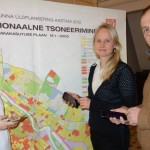Two-years-survey about campus-related mobility in Tartu, Estonia, has given profound evidence of the impact of campus location on urban travel load and individual activity choices in space and time. By studying the mobility and activity patterns of students and staff members of knowledge institutions, we found that well-integrated inner-city campus is favourable in front of out-of-centre campuses both on urban as well as on individual level. Inner-city campus helps to keep urban travel amounts lower, prevents suburbanization, and flourishes central city by bringing there people. High functionality of the inner-city area in turn provides individuals a wide variety of activity nodes, and enriches their personal life and the choice of freedom.
Out-of-centre workplaces tend to face poor accessibility by light travel modes. This fosters commuter traffic by car: people from out-of-centre workplaces and study buildings travel typically longer distances, and spend more time in traffic, particularly in motorized traffic. There are differences in the use of travel modes between the students and staff members as students can afford less car use. This puts the students to a more vulnerable position in terms of travel time than staff members. In addition, car-dependency creates large and visually unappealing parking areas around out-of-centre knowledge institutions.

Change in the use of urban space due to workplace relocation from inner-city area (left) to opposite edges of the city (right). (Source: Mobility Lab of the University of Tartu. Basemap: Google.)
These results have been gained during the Live Baltic Campus project funded by Interreg Central Baltic programme and the State Real Estate Company. Within the project, we built up an experimental study to analyse the mobility and activity patterns of close to 270 people from knowledge sector. Volunteering participants of the study were academic staff and students of the University of Tartu, and employees of the Estonian National Museum and the Estonian National Archives. The latter institutions both faced workplace relocation from central Tartu to the edge of the city during the research period. This enabled real-life experiment about the changes in mobility, activities, and time-use among the employees of knowledge institutions. In-depth analysis of the collected data is going forward.
The survey applied infotechnological tools and methods for data collection and analysis. Main data collection occurred with the help of smartphone GPS tracking application MobilityLog. Data gained by digital means was thereafter combined with semantic information from individual interviews. MobilityLog is an Android-based application designed for long-term mobility tracking and social-network-related experiments. The application is jointly developed by the Computer Laboratory of the University of Cambridge and the Mobility Lab of the University of Tartu.
Research conducted by the help of MobilityLog aims to provide data for evidence-based and participatory spatial planning. Campuses bunching up thousands of people are a strong urban development promoter in social, intellectual, environmental, and economic sense. Current results about the mobility of campus tenants indicate a need for a strong city planning policy that supports high functionality and excellent connectivity by public transportation / light travel modes for areas under development. Rich functionality of an urban core supports the identity building of the city and increases its attractiveness. This is especially relevant in the context of global battleship for talented people.









